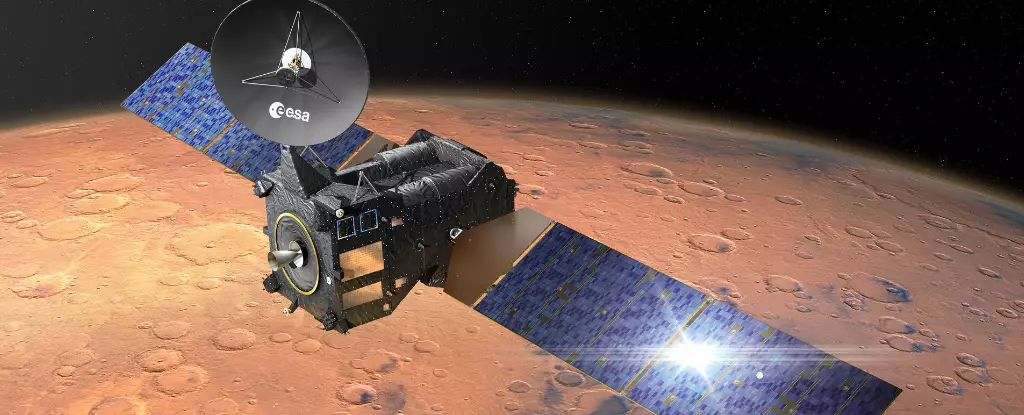In May 2023, a groundbreaking experiment unfolded in the realm of space exploration and public engagement: the European Space Agency’s (ESA) Exomars Trace Gas Orbiter (TGO) sent a remarkably crafted signal to Earth, intended to simulate what an extraterrestrial communication might resemble. The project, intriguingly dubbed “A Sign in Space,” aimed not only to stretch scientific understanding but also to invite citizen scientists from around the globe to participate in the unfolding drama of decoding the enigmatic transmission. This initiative is the brainchild of multidisciplinary artist Daniela de Paulis, who, leveraging her expertise in media art and radio operations, set out to blend art, science, and public involvement in a unique endeavor.
The inspiration for this cosmic experiment was drawn from Italo Calvino’s “Cosmicomics,” a collection of whimsical short stories that illuminate various scientific concepts through narrative. This thematic link infuses the project with a rich literary tradition, connecting creativity with the pursuit of knowledge. By collaborating with premier scientific institutions like the SETI Institute, the Green Bank Observatory, and the Istituto Nazionale di Astrofisica (INAF), the project sought to elevate the dialogue between science and society, highlighting the importance of collective human effort in the quest for universal understanding.
Upon receiving the simulated transmission, three radio astronomy observatories were poised to make sense of the raw data. The challenge set before the citizen scientists was not trivial; they were tasked with deciphering what could potentially be the first message from beyond our planet. This inspired campaign attracted over 5,000 participants from various backgrounds, all keen to apply their skills in data analysis and deduction towards constructing meaning from the signal.
In an age defined by rapid technological advancements, the synergy between citizen engagement and scientific inquiry has proven to be a valuable resource. For ten consecutive days, these individuals collaborated in an extensive online effort, drawing on their diverse expertise to extract the signal from its raw format. After a year of persistent trials and experiments, the breakthrough finally emerged from a remarkable father-daughter duo, Ken and Keli Chaffin, who successfully decoded the message.
Their findings revealed a stunning visual—a representation made up of five clusters of white dots against a deep black background, reminiscent of cellular formations. This visual representation sparked excitement, suggesting a direct connection to the very building blocks of life, namely amino acids. On June 7, 2024, the decoded image, along with an explanatory note from Ken Chaffin, captured an artistic yet scientific portrayal of amino acids using a universal molecular diagram.
Chaffin’s method incorporated complex principles of cellular automata, seamlessly blending computational theories into a visual interpretation that simultaneously highlighted the intricacies of molecular biology. His rigorous approach to decoding the message was anchored in a system that conserved points and conveyed detailed information through visual representation. The creativity involved in employing the Margolus reversible block cellular automata technique exemplifies the unexpected routes citizen scientists might take to tackle seemingly insurmountable challenges.
With the message decoded, the focus now transitions from extraction to interpretation. The team at “A Sign in Space,” along with the broader community of citizen scientists, faces an open-ended question: what does this message signify? Could it be an attempt at communication? A cultural exchange? Or perhaps an ominous warning?
This rich tapestry of inquiry underscores the profound philosophical implications of humanity stepping closer to potential contact with extraterrestrial intelligence. More than just a scientific milestone, this project raises ethical considerations and existential dilemmas regarding our preparedness for first contact. Are we culturally and socially equipped to face the implications that such a revelation presents?
Engagement avenues remain open for the public to delve deeper into analysis, making use of the findings shared by the Chaffins, while also prompting individual interpretations through discussion platforms like Discord. This participatory model of scientific inquiry demonstrates a pivotal shift toward inclusive exploration, empowering individuals to contribute their thinking and methodology towards understanding what lies beyond.
In embarking upon this ambitious endeavor, the “A Sign in Space” project has not only showcased the potential of citizen science but also sparked our collective imaginations about the cosmos. By intertwining art, science, and community engagement, it propels humanity forward—urging us to contemplate whether we are truly ready for the complexities that await us in the vast universe. The possibilities open to us now are as limitless as the stars themselves; with innovation and creativity, we write the next chapter in our quest to connect with extraterrestrial life.


Leave a Reply